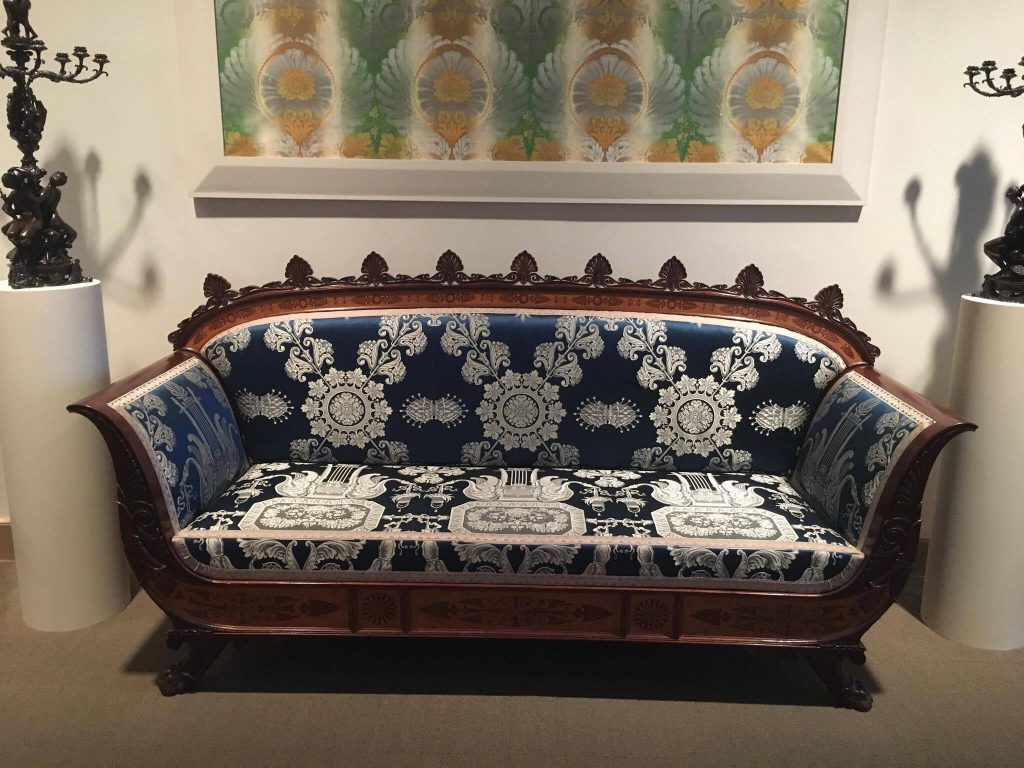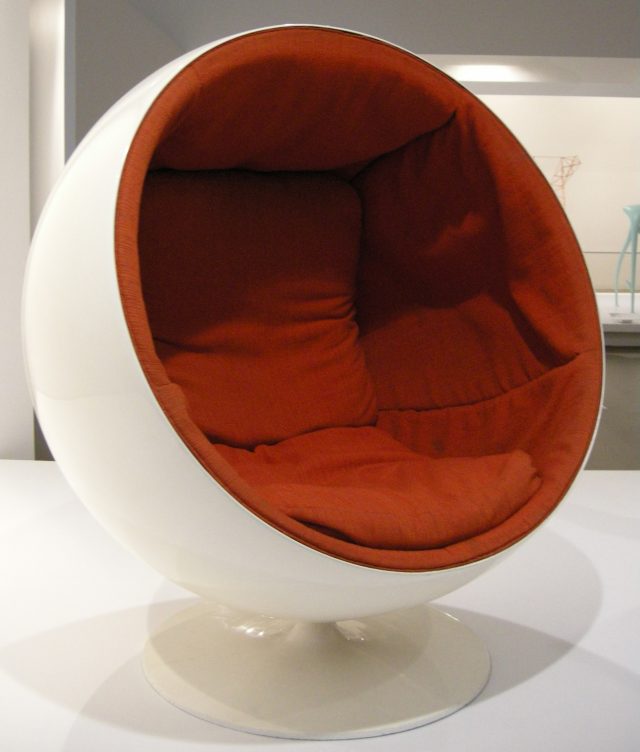I had a great uncle whose furniture selection made it clear how much he valued your company – he only had one chair.
The thing that often gets lost in the discussion of sitting disabilities is just how socially meaningful and culturally ingrained the act of sitting is. I started thinking about this yesterday, when I stumbled upon a 1979 meditation on chair design. The whole piece caused me to cycle between deep thought and existential angst, in ways I’m sure the author never imagined. This article pushed my buttons, and I wanted nothing more than to push back.
The First Furnishings
Caplan asserted that, “A chair is the first thing you need when you don’t really need anything.” I wanted to pick a fight, until I remembered that Past Me had already proven him right.
When I sacrificed the use of my roommate’s furniture and moved into my own New Jersey apartment, the first thing I bought was a couch. It wasn’t entirely my choice – my Mom and aunt (not unreasonably) wanted a place to sit, and insisted I get at least one piece of furniture. Since they had driven across the country to help me move out of my fourth-floor walkup apartment in Brooklyn, it seemed like a fair concession.
When I bought my couch, the three of us tested the various angles and sitting positions, to make sure the high arms and back wouldn’t be too obtrusive. I judged it good, without realizing how little sitting I would actually be doing in it. (At least I got my money’s worth – I slept on it every night for years.)
It seems my Mom wasn’t the only one to demand a place to sit. This little story must have played out countless times, starting thousands of years before I was even born. Back when the ancient Mesopotamians were busy inventing civilization, some six thousand years ago, one of their first accomplishments was inventing chairs. Ancient Egyptians, Greeks, and Romans all used chairs, although the latter two had the good sense to recline during dinner parties.

This ancient statue shows a Mesopotamian goddess sitting on a stool. Which makes me wonder, which came first? Sculpture, religion, or chairs?
In my apartment, the other chairs, which my family assumed I would eventually buy, never materialized. I had a mattress against a wall, which seemed far more practical for my purposes. To placate visitors, I kept a supply of fabric folding chairs in a closet. I could easily fold them up and set them aside when company left and they threatened to trip me.
For a wedding present, my parents bought my husband and me a La-Z-Boy recliner. They bought it for him, really, no doubt out of sympathy for his longstanding (pun intended) chair deprivation. They chose well. Sitting in his chair with a beer in his hand, my husband is the very picture of contentment.
I, on the other hand, have to contort myself around the other furniture to maintain some degree of comfort. I kneel on the floor in front of the coffee table for video calls. I pour my tea into travel mugs so I can drink it lying down. I Iean against a wall to catch the end of a TV show. To my eyes, chairs are just portable shelves.
Other people’s houses require their own set of adjustments. At my grandmother’s house, the staircase leading to the basement is separated from the living room by a ledge. I’ve taken to standing a few steps down so I can remain at the same level as the people seated in the living room. I’ve been known to bring my own air mattress to friends’ houses. I’ve flopped around on couches that are too short, floors that are too hard, and futons that are the set at the wrong angle.
I have practically made love to pillars in public places, so determined was I to find some comfortable way to have them support my weight. I have tried resting in a deep squat, and determined the notion that anyone finds this a comfortable resting position is a myth spread by communists. I will twist myself up in arm supports on trains, and reconfigure car seats so I can pretend I’m competing in luge.
Sit, Sit
And then, there’s the social element of chairs, and sitting in them, and how that influences the dynamics of group interactions. Caplan clearly paid attention to those nuances. So have I, though in my case, I feel like Grendel looking into Hrothgar’s mead-hall.
Formal occasions, whether they are weddings or upscale business dinners, often involve a seating chart. Calling shotgun puts you in charge of both navigation and music. Sitting next to someone in the cafeteria is a declaration of your allegiance. An invitation to sit next to someone means they’d like to keep you around for a while.
But when you have a sitting disability, you often hover awkwardly at the periphery of these little human dramas, if you are invited to participate at all. You exist outside the framework. No one knows what to do with you.
Going to movies isn’t something I do with friends anymore. It can’t be a social activity when I’m shuttled off to the aisle, or into the wheelchair seat. I’m not well-situated to hear snide comments. No one wants to sit next to me, let alone behind me. And I don’t much like spending two hours standing on the cement floor, wondering what it would take for me to get a cupholder.
At restaurants, bar-height tables are my salvation. I can actually join the conversation that usually takes place around my navel. Bar-height tables mean that I can order hot soup, or a sandwich that requires two hands.

Office work is often an unsolveable puzzle, since there are expectations of conformity and fairness. You get a cubicle (or less, if your company has one of those horrible open office plans), and the dividers are the same height for everyone. You get a desk, and a chair, and please don’t be precious by asking for something more to your liking. If there is an ergonomics expert on hand, your life may be a little easier. But you are still not encouraged to order off-the-menu of options.
Conference rooms are usually arranged around a central table, and noticeably lack places to stand. Once, when my company reserved a hotel room for a day-long meeting, I requested a lectern be placed by the table in lieu of a chair. It didn’t seem optional. I needed to type, and I couldn’t think of any other way to manage it. Though everyone involved understood the reasons, I inadvertently and unavoidably sent a signal that I was trying to place myself above my senior coworkers. I spent the whole time literally talking over my colleagues’ heads.
Getting to and from anywhere is a conundrum if you want to go any way but seated. Caplan is dead now, but I can’t imagine any living designer with a working butt would be keen to heap praises upon the bucket seats that are an inescapable feature of cars and airplanes. I have come to think that the homeless people who spread themselves out across subway benches have the right idea.
When a Chair Isn’t Really a Chair
Chairs have had some philosophical significance at least since Plato started thinking about a chair so perfect it would embody the whole idea of chair-ness. Since that time, the idea of a chair has been siphoned off into other areas.
As Caplan points out, chairs have infiltrated into seemingly unrelated concepts, like “chairman” or “sitting judge.” If you are invited to join a decision-making group, you are given a seat at the table. You sit up and take notice of the violist who plays first chair. A good discovery means you are sitting on a gold mine. Sitting pretty, as it were.
But what happens, I wonder, when the sitting judge can’t take a seat? When the violinist eschews her deserved place or the chairman insists on a lectern? Can we stand as pretty as we sit? Can we recline on top of our gold mine? Or would this shock the system?
If standing on my hands sounds uncomfortable, at least I can stand back until I’ve got it sorted out.

This is so on point! I’m relegated to my bedroom because the rest of the house is stuffed with obstacles (I’m temp living with my parents). I dream of having space to move freely and have a standing desk. I’ve been approved for a home loan yet there are no small, accessible homes on the market near my support system. I’m glad I found this blog that expresses so much of what this feels like!
Ugh, I feel your pain! It’s not easy for me to spend time in other people’s houses. They just aren’t conducive to anything but sitting.
Good luck with your house search! I hope something that fits your criteria opens up. You must be looking forward to having a place of your own.